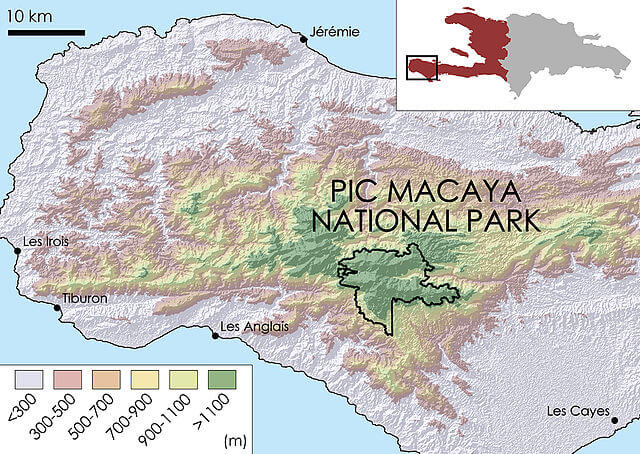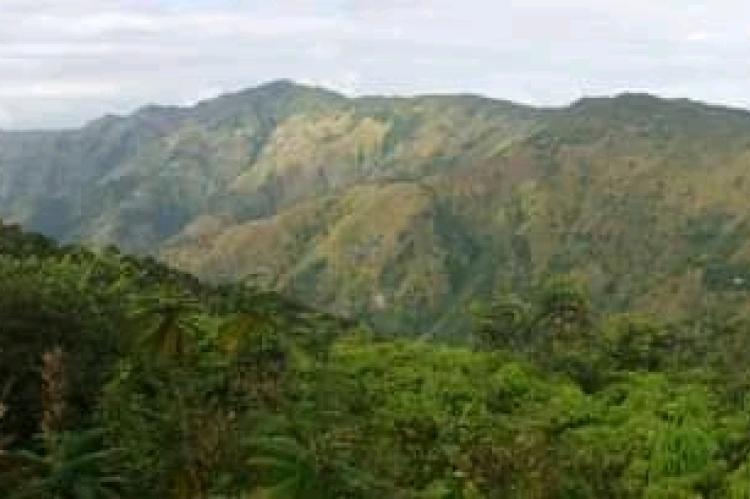Pic Macaya National Park: Haiti's Biodiversity Haven
Pic Macaya National Park in Haiti's Sud Department is known for its diverse landscapes, from subtropical lowland forests to montane cloud forests. As part of the Massif de la Hotte Key Biodiversity Area, it plays a crucial role in conservation efforts due to its high levels of endemism.
Exploring the Wilderness of Pic Macaya National Park
Pic Macaya National Park, established in 1983, is one of Haiti's largest protected areas, encompassing approximately 24,000 hectares (59,300 acres) on the Tiburon Peninsula in southern Haiti. This park, situated within the Massif de la Hotte mountain range in the Sud Department, is renowned for its diverse landscapes, ranging from subtropical lowland forests to montane cloud forests at higher elevations. As part of the larger Massif de la Hotte Key Biodiversity Area (KBA), Pic Macaya National Park is crucial for its high levels of endemism and its significant role in conservation efforts within Haiti.
Geographical and Ecological Overview: Landscape and Topography
Rugged mountains, deep valleys, and steep slopes characterize Pic Macaya National Park. The highest peak, Pic Macaya, is approximately 2,347 meters (7,700 feet) above sea level. The park's topography supports a variety of ecosystems, including subtropical lowland forests and montane cloud forests, which are essential for maintaining biodiversity and ecological processes.
Climate and Hydrology
The park plays a vital role in water conservation for the surrounding region. With an average annual rainfall of 4,000 millimeters, Pic Macaya supplies fresh water to seven significant rivers in Haiti's southwest peninsula. This abundant rainfall supports the park's lush vegetation and diverse ecosystems, making it a critical area for water resources.
Flora and Fauna: Vegetation
Pic Macaya National Park is home to Haiti's last stand of virgin cloud forest and supports over 900 plants, including 123 species of orchids. More than 50% of the park's 300+ species of vascular plants are endemic to Haiti. Notable plant species include the critically endangered palm, Gaussia maya, a variety of orchids, ferns, and rare and endangered trees. The park's diverse flora contributes to its reputation as a biodiversity hotspot and underscores its importance for conservation.
Wildlife
Although the park's fauna is less well-documented, Pic Macaya National Park is known to harbor a variety of birds, amphibians, reptiles, and insects. The park's remote and rugged terrain poses challenges for comprehensive faunal studies, but its biodiversity is nonetheless significant. Protecting these species is crucial for maintaining the region's ecological integrity and supporting Haiti's broader biodiversity.
Conservation Efforts: Importance and Challenges
Pic Macaya National Park is a cornerstone of the Massif de la Hotte Conservation Corridor, which aims to protect the entire Massif de la Hotte and its endemic species. Despite its protected status, the park faces significant challenges, including deforestation, poaching, and the impacts of climate change. Natural disasters like hurricanes and earthquakes threaten the park's ecosystems and biodiversity.
Conservation Initiatives
Efforts to conserve Pic Macaya National Park focus on mitigating pervasive deforestation and habitat destruction in Haiti. Conservation strategies include reforestation projects, community engagement, and the development of sustainable land-use practices. These initiatives aim to preserve the park's unique habitats and protect its endemic species from further decline.
Ecotourism Potential: Ecotourism Development
Ecotourism is gradually gaining popularity in Pic Macaya National Park. Guided tours allow visitors to explore the park's unique biodiversity and natural beauty. Ecotourism has the potential to generate economic benefits for local communities while promoting conservation awareness and sustainable practices.
Access and Infrastructure
Access to Pic Macaya National Park can be challenging due to its remote location and rugged terrain. Visitors often need to arrange guided hikes or expeditions to explore the park. Improving infrastructure and accessibility while maintaining the park's ecological integrity is crucial for developing sustainable ecotourism and enhancing visitor experiences.
Conclusion
Pic Macaya National Park is a vital component of Haiti's natural heritage. It offers a refuge for unique and endangered species and plays a crucial role in water conservation and biodiversity preservation. The park's diverse landscapes, from subtropical lowland forests to montane cloud forests, support a remarkable array of flora and fauna. Despite significant conservation challenges, Pic Macaya stands as a beacon of hope for Haiti's environmental future, showcasing the importance of protecting and preserving the country's remaining natural habitats.

Topographic map depicting the location of Pic Macaya National Park on the Tiburon Peninsula in Haiti.
